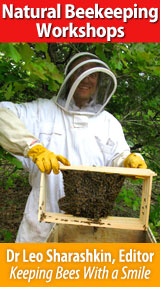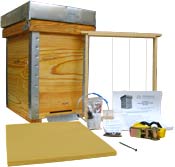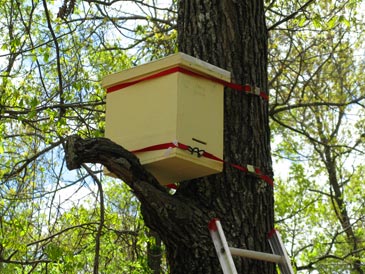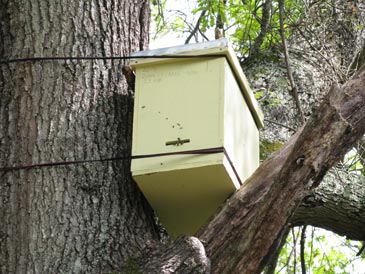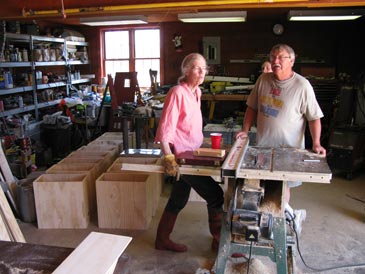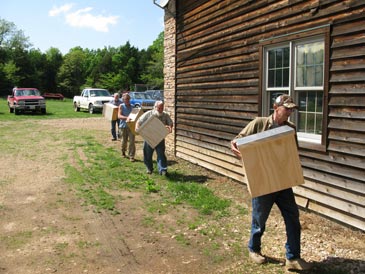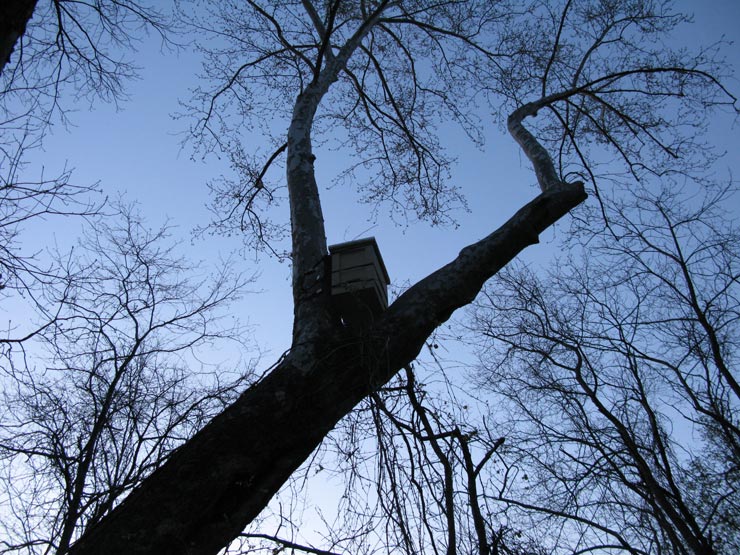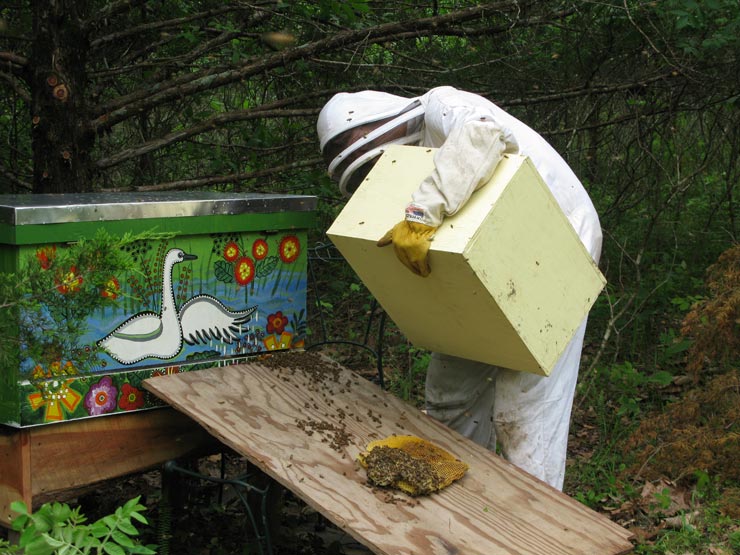I LOVE SWARMS: The Complete Guide to Attracting Honeybees
by Dr Leo Sharashkin, Editor, Keeping Bees With a Smile
SWARM TRAP KITS AVAILABLE FROM OUR STORE >>
Kits include everything, fully assembled & ready to go
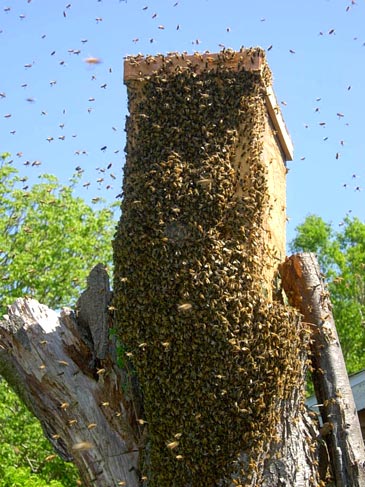
Please drink responsibly
Wild honey bee colonies are a precious resource which can be diminished through trapping. If you catch wild swarms, please help preserve and increase local honey bee populations by following natural principles: giving them the freedom to swarm, not subjecting them to any treatments, and preferably using foundationless comb so they can raise sufficient number of drones and pass on their valuable genetics to other colonies in your area. For an in-depth discussion of sustainable natural beekeeping methods, please see Keeping Bees With a Smile. Thank you!
The right sort of bees
Beekeeping begins with the bees. Every aspiring beekeeper wants to start out right with the bees that are healthy, productive, and resilient. But is it what you are getting? Judge for yourself: most of the bees sold in the commerce are mass-produced under highly unnatural conditions. The queen bee is fed sugar syrup to accelerate her egg-laying; when her “sugar babies” mature, they are fed more sugar syrup, sold by the pound, packed in boxes, and shipped with a new queen that was likewise specially raised and artificially inseminated. These “package bees” will cost you upward of $100 plus shipping, and it is recommended that you medicate them even to get them through their first winter. Yes, they may produce honey, but they are completely dependent on you, and their genetics not necessarily a good match to your local climate and conditions. Remember Winnie-the-Pooh talking about “the wrong sort of bees” that “make the wrong sort of honey?” There you go.
But what is the alternative? The alternative would be to get local bees that are adapted to your conditions. “Pick the hive model that is best suited to your locale, populate it with local bees, and the results will speak for themselves,” wrote the famous French apiculturist Georges de Layens in his book The Complete Course in Apiculture, first published in 1892. But where do you buy local bees? Fortunately you do not even have to buy them. They come for free.
The best things in life are free. Bees are no exception
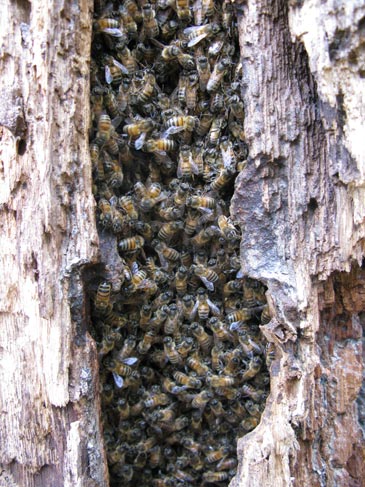
“Now that is the kind of bees I’d like to have in my hives,” I thought. “Nobody fed them or protected them from predators (ouch! they can stand for themselves!); nobody treated them against diseases and mites; they don’t even have a proper home — but there they are, fruitful and multiplying — the right sort of bees!”
How do you get these bees from the bee tree into your hives? No chain saw necessary! Each spring the colony becomes congested because of the new generations of young bees being born. So they raise a new queen, and when she matures, the old mother queen with half of all the bees departs from the nest, leaving the remaining half as well as the home with comb and honey and goods and chattel as a dowry for the young queen. That is how bees procreate; instead of one colony, there become two.
The mass of bees (often tens of thousands of them) that emerge from their old home is called a swarm. They will temporary settle on a branch or some other object, forming a “beard,” and scout bees will go from there in all directions searching for a new home such as a tree hollow. So if you place on a tree a box that will look to the bees as a suitable new dwelling, the scouts will signal their sisters (all worker bees are female) to come and occupy the box. Not unlike a birdhouse: you set it out, and the birds move in. Same here: you set out a special “bee house,” and the bees move in. As simple as that. Besides, you do not even need to know where the bee trees (or the swarming hives) are located: a swarm can travel ten miles or more in search of a nice new home.
Bee welcome — swarm traps that work
The box to attract the bees — called bait hive or swarm trap — is basically any watertight wooden or plywood box with a volume of 40 to 70 liters (10 to 18 gallons) and a two-square-inch entrance towards the bottom of one wall.
There are many swarm trap models, and even an empty carton can catch you a swarm. But if you rely on swarms for starting and increasing your apiary and use them as a natural alternative to splits and requeening, the conventional swarm traps have their shortcomings.
The commercially available wood pulp swarm traps, which look like flowerpots, require frequent checking (or the bees will build comb right in the trap). They are too small, not durable, and quite expensive for such a short-lived contraption.
Nuc boxes are too small to be effective, with too small of an entrance, and usually require a special rack to install.
Deep Langstroth boxes are the right size, but also require a rack because of their shape. Besides, you need ten frames to fully equip each deep box, so if you hang dozens of traps, that’s a lot of equipment tied up in the swarm-catching adventure. Deeps are also too wide to comfortably carry up and down the ladder with one hand.
All things considered, if you only need a few traps, deep bodies (or two five-frame nucs connected together) are the way to go. Old boxes from healthy colonies work best: both their smell and propolis deposits are attractive to swarms. Make sure to give it a telescoping top to keep elements out. You would not move into a damp apartment with a leaky roof, would you?
But catching swarms can be addictive. I am a living witness to that, with some 40 swarm traps ready to be set out in the spring. (And in case you are starting to wonder, I do have a job, a family with four kids, and a farm to take care of.) I use the basic model proposed by Fedor Lazutin in Keeping Bees With a Smile, with a number of modifications. For me it fills the bill for an ideal swarm trap and I’ve had similar feedback from others who use it. This past season my neighbor built 12 boxes like that and caught 11 swarms. My success rate of 50% looks lame compared to that!
All I want in a swarm trap
Here is my wish list for an ideal swarm trap, and this model delivers:
- The right size — between 40 and 60 liters (10 to 15 gallons or 1.5–2 cubic feet). Numerous researchers demonstrated this is the size preferred by scout bees and most often occupied by swarms. The swarm traps I build are 40 to 53 liters. Ten-frame Langstroth deeps are 43 liters — good! Nuc boxes are only 23 liters, but you can connect them in twos to obtain 46 liters. A ten-frame Langstroth medium super is 29 liters, and an 8-frame — 24 liters. A seven-frame Layens hive is exactly 40 liters.
- Entrance 2 square inches — mimicking the size of entrances commonly found in natural tree hollows. I cut a bird-proof slit entrance 1/2” high and 4” long.
- Lightweight — 15 lb or less. You’ll be scaling trees with it! So it should be light enough to hold safely with one hand while climbing up and down the ladder.
- Durable — to last ten years or more. Swarm trap success rate increases with age. The more swarms you catch in it, the more pheromones linger in the box, making it ever more attractive to new swarms. I dropped mine from the tree with zero damage (don’t stand under the ladder!), and no marauding squirrel was ever able to scratch its way into the box.
- Weather-tight — should not let any rain in. Damp swarm traps are rarely accepted by bees. This means I need a telescoping cover in my climate. Migratory covers or nuc-box-style covers did not prove reliable under heavy rains.
- Economical — it costs only $15 to build using materials available from any building supply store. Building at least 8 at a time makes best use of plywood.
- Easy to build — accessible to someone without woodworking skills or power tools. I use electric tools to speed things up (1 hr per trap), but this model can also be built with a handsaw, a hammer, and a screwdriver (2 hr per trap).
- Taller than it is wide — this shape is convenient to carry under one arm and easy to attach to the tree with ratchet straps, requiring no additional racks.
- No rack required to attach it to the tree.
- Infrequent visits — it can be checked every 2 to 3 weeks, and the bees won’t run out of space. This is especially important when the traps are spread over a large area and require a bit of driving to get to.
- Easy transfer of swarms into permanent hives — which means the trap has to have frames.
- Accepts your standard frames — for the same reason of compatibility and ease of transfer into the hive. Most beekeepers use Langstroth frames. I prefer Layens frames and hives.
- Accept extra-deep frames — e.g., the old Dadant brood frames 11-1/4” deep or even Lazutin frames 18-1/2” deep. For me it is important because I run most of my hives with the 16”-deep Layens frames.
- Cheap to equip — requires a minimal number of frames. My traps take only 5-7 frames; that is 40% less than a 10-frame box. I use foundationless frames, saving the cost of foundation and the time it would take to install.
- Scout bee friendly — Thomas Seeley describes in Honeybee Democracy how scouts measure the cavity’s volume to determine if it is large enough to house the colony. They walk on the walls and fly from one wall to another. If the box is fully filled with empty frames, it could give impression of smaller volume. The Langstroth swarm trap model has almost 60% of the volume free of frames, and should feel like a spacious dwelling.
My father, who helped me build a batch of my first-generation traps, told me I should patent the design, or at least sell the plans. But I’d rather see more people build these traps, enjoy them, and increase the genetic diversity of local bees by catching resilient feral swarms. A swarm trap on every tree — that’s my vision of America of the future.
SWARM TRAP FREE PLANS — SEE HERE
We have free plans for Layens swarm traps and Langstroth swarm traps.
Preparing the trap for first use
- Generously rub all interior surfaces with propolis.
- Apply a few drops of lemongrass essential oil (more on lures below).
- Insert six frames and drive four small nails into the frame rests so the frames don’t shift.
- Close the top and secure it to the swarm trap body (front and back walls) with four 1-1/8” deck screws (pre-drill top’s rim so it does not split).
- Weigh the swarm trap. This way you’ll be able to find out the size of the swarm that moves in.
Hanging a swarm trap
Whenever possible I just drive my minivan up to the tree, climb on the roof, and hang the trap from there (I have a wide board strapped to the roof rack to serve as standing platform). Otherwise I use a 20-foot extension ladder.
There are several ways to attach the trap to the tree. The quickest option is to tie a piece of wire around the box right under the rim of the telescoping cover (four screws hold the cover in place). Twist the wire to make a 2” loop in the center of the long side that will face the tree. Drive a screw into the tree and hang the box on it, like a painting. Then secure it to the trunk with a ratchet strap.
Another possibility is to pick a tree with a large limb at the needed height. Put the swarm trap on the limb and strap it to the trunk with two ratchet straps. I position the ratchet straps loosely in place before raising the trap into the tree.
Finally, you can raise the trap on a rope. Swing it over a branch, tie around the trap, and pull. Tie your end of the rope, climb up and strap the trap to the trunk with two ratchet straps. You can then release the rope — the straps will hold the box.
Tilt the trap forward just a bit so rainwater does not run in through the entrance. If you use foundationless frames (or just top bars), set the trap as level as possible, so the bees build straight comb.
Keys for successful use
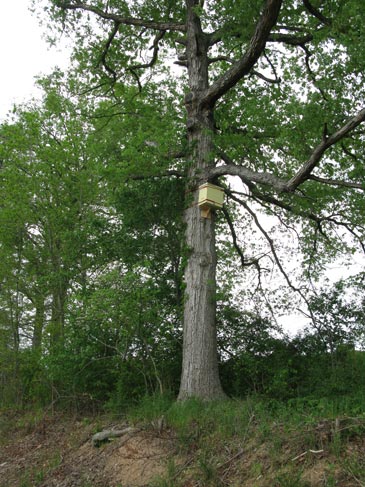
- Baiting — if the box was not previously occupied by bees, I scent it with propolis. Warm it in your hand for a few minutes and when it becomes supple and sticky, thoroughly rub all interior surfaces. Then add some lemongrass essential oil in slow-release tubes. The oil’s smell is highly attractive to swarms, and the special tubes release it over 6 months! (Some people put a cotton ball with a few drops of oil into a Ziploc bag — that’s better than adding oil straight into the trap, but not as good as the slow-release tubes.) The expensive commercial pheromone lures do not work any better than lemongrass essential oil in slow-release tubes.
- Dark comb — the scent of wax and old comb is attractive to swarms. Add at least one frame of dark comb if you have it. Even the frames that you would otherwise discard make a good addition to the trap. Make sure they come from healthy colonies and sanitize by freezing for 48 hrs to kill pests. I’ve never heard about wax moths posing a problem for swarm traps — possibly because traps are set out early in the season.
- Ideal height — 12–15 feet off the ground is best, as confirmed by numerous studies. It is possible to catch swarms in traps positioned lower, but scout bees seek sites offering good protection from predators and damp ground, so they first look higher up. Together with baiting (scenting) the box, the height is reported to be especially important.
- High visibility — if you cannot see the trap from 100 feet, the bees will have trouble discovering it. Traps hidden behind leaves and branches are rarely occupied.
- Full shade desirable — bees reject a box if it overheats. If you do not have full shade, at least put it in partial shade or on the north side of the tree trunk.
- Light box color — by the same token, do not paint the box with dark paint to avoid heat buildup. You can leave the trap unpainted, but priming and painting it in a light color (e.g., white, light gray, etc.) will significantly prolong its useful life. If swarm trap theft or vandalism is a potential issue where you live, you can paint it in a light camouflage pattern that blends in. In Russia many beekeepers glue a thin layer of bark all over the trap. It gets heavier, takes additional work, but becomes almost invisible to human eyes.
- Large landmark trees work best — on the edge of the woods, along country roads, power lines, in fencerows, yards, etc. Bees see fork shapes particularly well, and I had lots of luck with trees that have a clear trunk with large boughs coming from it.
-
Proximity to swarming colonies — it surely helps to know the location of bee trees and bee yards. But do not put the trap too close to the existing colony. Winston (The Biology of the Honey Bee) cites studies suggesting the good range from several hundred feet to 1 mile from the hive. My traps on bee trees or right by a bee tree never worked. But swarm traps positioned as little as 50 or 100 ft from the known colonies were repeatedly occupied.
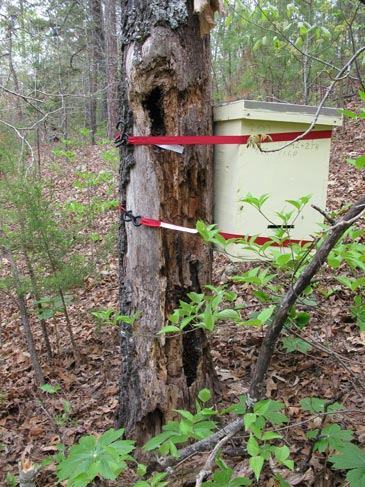 The bees proved totally indifferent towards the swarm trap attached right to their bee tree. A swarm preferred to move into a similar box hung some 50 ft away on an oak tree, property raised 15 ft off the ground.
The bees proved totally indifferent towards the swarm trap attached right to their bee tree. A swarm preferred to move into a similar box hung some 50 ft away on an oak tree, property raised 15 ft off the ground. - Places bees visit — the scout bees that look for a new nest site are the same bees that were previously foraging for nectar and pollen. They will first look in the places familiar to them. This is why “high traffic areas” — gardens, orchards, and especially areas with a rich diversity of wild nectar plants (meadows, bottom fields, glades, old fields reverting to natural vegetation) are particularly suitable. Areas with little bee food (e.g., pastures or conifer forests) rarely attract a swarm.
- Source of water — water is an everyday necessity for any bee colony. I am finding that 100% of the swarms I catch occupy traps hung within several hundred feet of a creek or pond. This may be especially relevant for locations with hot, dry summers. In dry areas in Russia some beekeepers hang plastic water jugs right by the swarm trap. (Usually a 2-liter soda bottle or a 1.5-gallon drinking water jug.) They pierce a pinhole in the lid, reverse the jug and let water slowly drip on a piece of board attached by the trap. Bees discover the “fountain,” come to collect water, learn the location, and the swarm trap is more easily discovered.
- Spread traps 1–2 miles apart — this maximizes your chances. If you hang traps close by, scouts from the same swarm may discover two or more of them — and, the traps being identical, will have a hard time deciding which one to choose!
- Swarm trap materials — wood, plywood, and wood pulp are all acceptable. Natural tree hollows have rough wall surfaces, so no need to try to make them too smooth. If you use wood, rough-sawn boards are actually preferable (and cheaper) to planed lumber; if plywood — regular construction grade works perfectly well, no need to invest in sanded plywood. If you walked on the walls, you’d surely appreciate some traction, wouldn’t you?
- Entrance orientation — some studies have shown slight preference for south facing entrance exposure, but in practice I have not yet met a beekeeper who diligently orients swarm traps with compass in the hand. The majority of my swarms fly into traps with north-facing entrances! If anything, the entrance orientation should be convenient so you don’t have to get out of your vehicle (or, in case of my daughter, get off her horse) to see if the box is occupied.
- Stick to your lucky trees! The trees and sites that caught a swarm keep attracting more swarms — later the same season and in subsequent years. So putting up an empty trap as you take down the one with the swarm is a very good idea.
Here comes the swarm
After hanging the traps early in the season, you go about puffing dandelions and reciting your favorite swarm-catching charms, all the while experiencing the high of playing at a high-stake lottery. Check traps occasionally. If you see lots of bees at the trap entrance (congratulations!) come back to collect the trap at nightfall, after all foragers returned from the field. Before pulling it down, place your ear against the trap and gently knock on the wall. Loud vigorous hum indicates a resident swarm. If the box is silent or you can hear a few bees but it sounds hollow, what you have seen during the day were the scouts that discovered the box, and the swarm is likely to arrive within the next day or two. Please come back later.
So if you see bees visiting the box, it does not yet mean the swarm moved in. It can be scout bees (usually dozens, but sometimes hundreds of them) that discovered the box. After the scouts appear at the box, it usually takes 2-5 days for the swarm to arrive (although occasionally the swarm never shows up at all). Checking the box after dark is the surest way to tell if the swarm is inside. Here are some additional cues:
- If you see a large mass of bees covering the box or adjacent trunk like a beard, this is a swarm that has just arrived; they will move inside within an hour or so.
- Bee movements: scouts move briskly, going in and out of the box many times, hovering around it in jerky movement (as if bumping their head against it), many leave and many new come, newcomers don't find the entrance straight away; scout numbers increase as time goes by.
- If you see some bees arriving with pollen (small balls of yellow, white, gray, or pink pollen on their hind legs), the swarm is surely in the box — scouts never carry pollen.
- Weigh the box — if it’s much heavier than the empty box, the swarm is inside.
- Just visit the trap one week after you first saw the bees in and around it. If you still see lots of bees after a week, busying in and out, the swarm is in.
If the swarm is inside, the trap is ready to be moved. If there is a bunch of bees chilling out on the front wall by the entrance, I take a gulp of water and spray them from my mouth. It looks like it is going to rain, so they move inside no questions asked. I cover the entrance with #8 hardware cloth (mesh wire) and staple it in place.
If the swarm trap tree is from 30 feet to 3 miles to where the permanent hive will be located, I first take the trap 6 miles away and leave it there for a week (with open entrance!), then bring and set it by the permanent hive. Without this procedure many bees leaving the hive will be flying to the original swarm trap location and congregating there; moving them away for a week resets their orientation system. If the hive is right under the swarm trap tree, no such precaution is necessary.
When working with occupied swarm traps in twilight, I use a headlamp with red filter. Bees can’t see red light — so you can see them without being noticed. Very handy.
If the weather turns rainy after a swarm arrives, I give them several pounds of honey lest they starve to death.
The transfer of bees from the swarm trap into the hive is very simple. Pull the frames from the trap and insert them into the hive in the same order. Whatever bees remain in the trap dump on a piece of plywood propped up against the hive’s entrance.
If the swarm you are transferring has not been in the swarm trap long enough to have brood, there is a small chance that it may abscond (fly off) after the transfer. This never happened in my practice; but if you want to be absolutely sure, giving the colony a frame of open brood from another colony helps anchor them to the permanent hive and prevents absconding.
Most beekeepers remove swarm traps from trees at the end of the main swarm season. In southern Missouri it is around the 4th of July. But I leave mine up until late September. While I never caught any swarms in July or August, there is a small spike of swarming activity in September. These late swarms are usually relatively small — 2 to 3 lb. They can be united with an existing hive. But I prefer to keep them in the swarm trap and let them build comb and forage until the first hard frost. After that I carry them inside and connect the trap entrance to the outdoors. Given 5 or 6 lb of honey they survive until the spring and develop into robust colonies the following season.
This guide is based on Dr. Leo Sharashkin’s articles that previously appeared in the American Bee Journal (March 2015 issue) and Acres USA (December 2014). My work on this guide was supported, in part, by your donations as well as the Sustainable Agriculture Research and Education (SARE) program funded by USDA National Institute of Food and Agriculture. Any opinions are my own and do not necessarily reflect the view of SARE or USDA. Everybody’s support is much appreciated!
SWARM TRAP KITS AVAILABLE FROM OUR STORE >>
Kits include everything, fully assembled & ready to go
Please join our email list below for more free plans and important updates (no spam; only 2-3 emails per year, and you can unsubscribe at any time). We are working on bringing you the bees... and the smile!




